Throughput is a measure of how many units of information a system can process in a given amount of time, typically measured in Kbps (kilo bits per second) or Mbps (mega bits per second).
Under our expertise in storage system structure, Surveon NVR can support up to 5 megapixel recording with a high level of recording throughput of 6 Mbps per channel, ensuring cameras can be recorded and viewed without frame drop.
RAID (Redundant Array of Inexpensive Disks) is the way of combining several independent and relatively hard disks into a huge, fast, and protected storage of a large size. Hard disk is often used as a storage device, but it has the worst I/O performance in whole storage system. RAID is designed to enhance the throughput of storage system and improve the security of hard disk. There are some common secure RAID levels:
| RAID 1 (Disk Mirroring) Data are stored twice by writing them to both data drive and mirror drive. User needs at least 2 drives for a RAID 1 array. |
RAID 5 (Disk Striping with Interspersed Parity Disk) RAID 5 is the most common secure RAID level. It requires at least 3 drives and can withstand a single drive failure without losing data. |
RAID 6 (Disk Striping with Two Interspersed Parity Disk) With RAID 6, the RAID array will even survive that second failure. It requires at least 4 drives and can withstand 2 drives dying simultaneously. |
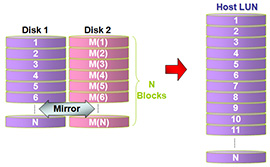 |
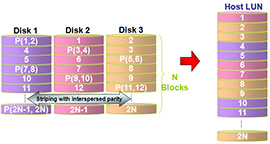 |
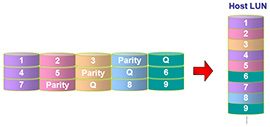 |
Surveon RAID plus spare volume gives user a hot-spare that is ready to synchronize data immediately should a hard disk fail. If a hard disk fails, the data will start to synchronize with the spare, giving users enough time to replace the failed hard disk after being notified. The system will reserve one hard disk to be the spare drive, elevating protection level to prevent data loss from broken hard disk.
Surveon NVRs provide IDR + spare drive solution with superior RAID protection and ensure smooth performance with patented read/write technology, keeping data secure against errors and loss.
The technology allows recording to be continued by collaborative NVRs within the system. The NVR with Failover function can record for other NVRs when it failed. For example, there have two NVRs (NVR1, NVR2) performed recording under normal situation while NVR1 is with Failover function and NVR2 is the protected NVR. When NVR2 is detected as no responding or working for certain time, the system will be determined as failed. NVR1 will start importing NVR2 configuration and take over to record for NVR2 automatically to minimize video loss.
Distinguished from other failover solutions, Surveon provides a flexible system architecture to implement mutual recording backup among multiple NVRs without keeping a spare one just for this purpose. The failover NVR not only supports video recording, but also provides seamless live view and playback of the videos from the failed NVR if the videos are recorded to the external storage. Moreover, Surveon Failover solution allows the license of camera to be shared with the Failover ones, making it the best C/P solution for large applications.
Video Analytics (or Video Intelligences) was created to help review the videos of surveillance system that a security guard or system manager may never have time to watch. Many different functionalities can be implemented in VA to make your surveillance system more efficient, reduce the workload on security staff, and help you capture the value of videos by making IP camera system more intelligent in its work.
By performing the real-time analysis of the video stream, Surveon Video Analytics identifie and initiate alerts for various user-defined events, offering effective monitoring, detections, alerts, and responses to events for a variety of applications. Surveon VMS has built in 12 video analysis, including motion detection, intrusion detection, forbidden area detection, virtual fence, going out detection, missing object detection, foreign object detection, object loitering, fisheye auto tracking, tailgating detection, people / vehicle counting, tampering detection.
When it comes to data recovery, the difference between data backups and archives is one of the most common questions among IT pros. Backup is a copy of data that can be used to restore the video which is damaged. Archive is a collection of historical records that are kept for long-term retention and used for future reference. Generally speaking, backup is a copy of a set of data, while archive holds original data that has been removed from its original location.
Surveon allows the video recordings to be backed up to USB HDD devices or iSCSI Storage, giving partners more options to save the valuable recordings.
Internet Small Computer System Interface: A TCP/IP-based protocol, transferring data by carrying SCSI commands over IP networks.To reduce the total cost of increasing storage demands, IT pros leverage the current network infrastructure to implement iSCSI storage.
All Surveon NVRs support iSCSI for large data storage.
JBOD stands for Just a Bunch of Disks. It is defined as a collection of disk drives contained in a single drive enclosure. JBOD is a type of multilevel configuration for disks that have not been designed for a RAID array.
All Surveon desktop and rackmount NVRs support JBOD expansion, allowing partners to easily expand number of retention days with large capacity.
Video management software or video management system, is the software component of a network video recorder and digital video recorder. After collecting videos from cameras and other sources or recording/storing these videos to a storage device, VMS provides an interface to both view the live video, and access recorded video. Aside from basic functions, VMS tends to be more sophisticated with options like video analytics or other advanced functions to manage videos. Central Management System (CMS) is designed to enhance remote viewing of video when a large number of cameras and recorders are involved.
Scalable and effective, Surveon VMS is based on the client-server architecture and featured with intuitive monitoring, real-time detection, intelligent searches, video analytics, investigative tools, multi-access, easy scalability, and optimized megapixel recording to deliver highly integrated and reliable solutions.
TV or matrix wall consists of multiple computer monitors or TV screens tiled together contiguously or overlapped in order to form one big screen. They are usually found in control rooms for security guard to monitoring easily.
Surveon Control Center (SCC) is a powerful add-on suite based on the Surveon VMS, providing superior features including interactive video walls, matrix screen displays, centralized alarm management, and high scalability for thousands of cameras and multiple clients. SCC is an effective solution for partners to take on middle to large scale, mission-critical security projects.
A redundant power supply contains two (or more) power supply units inside it. Each power supply is capable of powering the entire NVR and only one runs at a time. If one power supply fails, the other one will start running to keep the NVR powered up. The redundant power supply is important for NVRs to minimize the chance of shutdown or failure.
All Surveon Corporate Series NVR are equipped with redundant power.
The inner of NVR is without cable, reduce dust and create better circulation to lower the heat inside the machine. This is also the industry's first modularized design in server that caters to enterprise projects.
All Surveon Corporate Series NVR are equipped with cableless design to prevent thermal issues for long-hour non-stop operations.
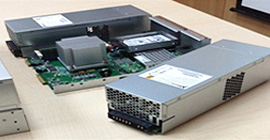
Swappable controller board prevents damage and operational faults when the HDDs are inserted, which help protect the fans and power supplies, make maintenance simple and lower the repair cost.
All Surveon Corporate Series NVR are equipped with swappable controller board.
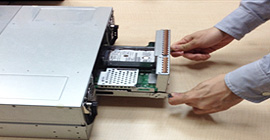
Hot swapping allows users to replace or add components without stopping or shutting down the system. Users can change broken hard disks when NVR is running.
All Surveon Tower and Corporate Series NVR have hot-swappable function.
These are three different kinds of storage architectures. DAS (Direct Attached Storage) is an external storage system which is directly attached to a server without network in between. SAN (Storage Attached Network) is a network of storage devices that can be accessed by multiple servers. NAS (Network-Attached Storage) is a file-level storage device which is connected by IP network.
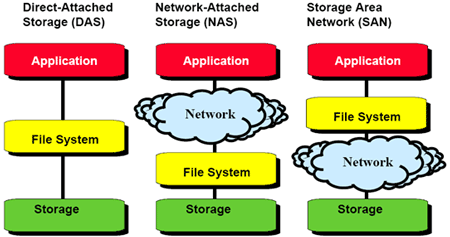
These two are the most popular storage system technologies. The File level storage is usually deployed in NAS systems. The storage disk is configured with a protocol such as CIFS and NFS. The Block level storage is always deployed in DAS and SAN storage and each block can be controlled as an individual hard drive and formatted with the required file system.
Snapshot provides instantaneous point-in-time copy of data without consuming equivalent disk space. With copy-on-write design, snapshot protects data from accidental modifications, deletions, and corruptions of performance overhead. By accessing a snapshot copy as the desired recover point, users can immediately restore system from a data disruption.
It allows user to quickly and easily create multiple disk-based data copies on storage systems at minimized performance degradation. Besides rapid recovery, these data copies also can be used for secondary applications, such as testing, development and decision support.
It's a process of copying data from one location in a storage device to another location of the same or different storage device to ensure that the same data is intact and accessible when disasters happened. Data replication can be implemented synchronously or asynchronously, depending on the overall system structure and the needs for immediate recovery from data.
Surveon data replication achieves enterprise-class capabilities at affordable price points. As the final protection level of Triple Data Protection, data replication gives user the most solid solution to secure their data.
It allows user to allocate a large amount of virtual capacity for an application server regardless of the actual available physical capacity. Actual space is used only when data writes occur. By automatically allocating system capacity to applications as needed, thin provisioning technology can significantly increase storage utilization.